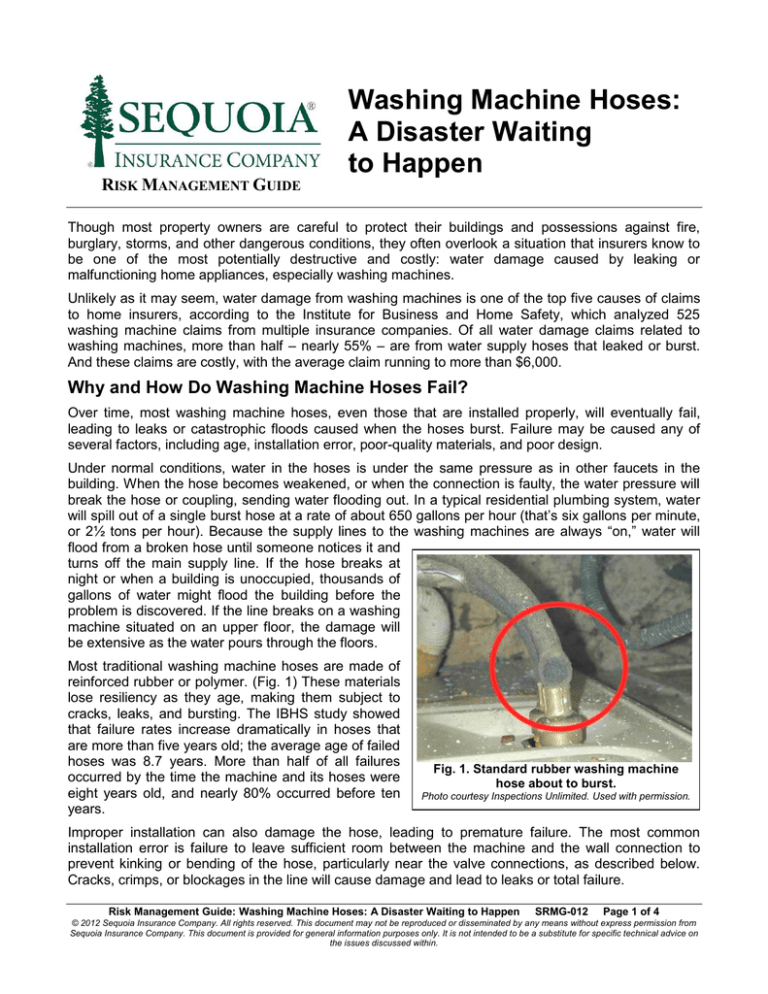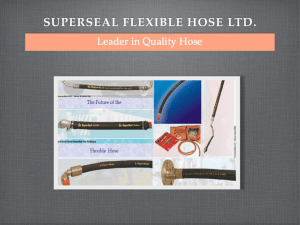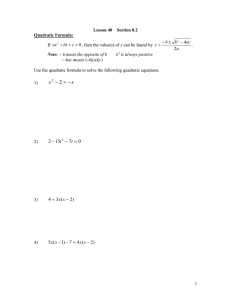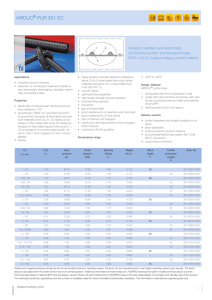
Washing Machine Hoses:
A Disaster Waiting
to Happen
RISK MANAGEMENT GUIDE
Though most property owners are careful to protect their buildings and possessions against fire,
burglary, storms, and other dangerous conditions, they often overlook a situation that insurers know to
be one of the most potentially destructive and costly: water damage caused by leaking or
malfunctioning home appliances, especially washing machines.
Unlikely as it may seem, water damage from washing machines is one of the top five causes of claims
to home insurers, according to the Institute for Business and Home Safety, which analyzed 525
washing machine claims from multiple insurance companies. Of all water damage claims related to
washing machines, more than half – nearly 55% – are from water supply hoses that leaked or burst.
And these claims are costly, with the average claim running to more than $6,000.
Why and How Do Washing Machine Hoses Fail?
Over time, most washing machine hoses, even those that are installed properly, will eventually fail,
leading to leaks or catastrophic floods caused when the hoses burst. Failure may be caused any of
several factors, including age, installation error, poor-quality materials, and poor design.
Under normal conditions, water in the hoses is under the same pressure as in other faucets in the
building. When the hose becomes weakened, or when the connection is faulty, the water pressure will
break the hose or coupling, sending water flooding out. In a typical residential plumbing system, water
will spill out of a single burst hose at a rate of about 650 gallons per hour (that’s six gallons per minute,
or 2½ tons per hour). Because the supply lines to the washing machines are always “on,” water will
flood from a broken hose until someone notices it and
turns off the main supply line. If the hose breaks at
night or when a building is unoccupied, thousands of
gallons of water might flood the building before the
problem is discovered. If the line breaks on a washing
machine situated on an upper floor, the damage will
be extensive as the water pours through the floors.
Most traditional washing machine hoses are made of
reinforced rubber or polymer. (Fig. 1) These materials
lose resiliency as they age, making them subject to
cracks, leaks, and bursting. The IBHS study showed
that failure rates increase dramatically in hoses that
are more than five years old; the average age of failed
hoses was 8.7 years. More than half of all failures
occurred by the time the machine and its hoses were
eight years old, and nearly 80% occurred before ten
years.
Fig. 1. Standard rubber washing machine
hose about to burst.
Photo courtesy Inspections Unlimited. Used with permission.
Improper installation can also damage the hose, leading to premature failure. The most common
installation error is failure to leave sufficient room between the machine and the wall connection to
prevent kinking or bending of the hose, particularly near the valve connections, as described below.
Cracks, crimps, or blockages in the line will cause damage and lead to leaks or total failure.
Risk Management Guide: Washing Machine Hoses: A Disaster Waiting to Happen
SRMG-012
Page 1 of 4
© 2012 Sequoia Insurance Company. All rights reserved. This document may not be reproduced or disseminated by any means without express permission from
Sequoia Insurance Company. This document is provided for general information purposes only. It is not intended to be a substitute for specific technical advice on
the issues discussed within.
Poor design (including fabrication from poor-quality materials) is probably
the most significant factor in the failure of both kinds of hose commonly in
use – the standard black rubber hose and the braided steel variety –
though these products usually fail for different reasons, as described below.
Standard black washer hoses are made of rubber tubing with a polyester
reinforcement lining. (Fig. 3) The metal inserts at the coupling end are
rolled and stamped from thin sheets of copper alloy. Most failures occur at
the end of the hose, where the metal insert comes into contact with the
tubing. (Fig. 2) Failures generally occur for one of the following reasons:
Razoring — The metal insert has a very sharp edge which is in direct
contact with the rubber tube. This edge becomes progressively thinner
and sharper as it is worn away by the movements of the water and by
the effects of electrolysis. In a process called “razoring,” the motion of
the washing machine causes the metal edge to rub repeatedly against
the inside of the hose, cutting it gradually from the inside out.
Fig. 2. Burst rubber
washer hose.
Photo courtesy PMC
Plumbing. Used with
permission
Stress Fractures — The metal insert is attached to the hose by a ferrule,
or ring, which is crimped tightly to hold the pieces together. The crimping
can cause a stress fracture in the hose, which is then subject to failure, especially as the rubber
ages and begins to deteriorate.
Rusting — Corrosion (rusting) of the metal fitting can cause failure in two ways. First, as the thin
metal fitting corrodes, it becomes jagged and rough and cuts into the hose as the washing machine
operates. Water can leak between the hose and its outer covering, forming a bubble, a critical
warning sign of imminent failure. (Fig. 1) Though a bubble may appear anywhere along the line,
most breaks occur at the point where the metal fitting meets the rubber tube. Second, as the fitting
continues to corrode, it can become so weak that it may eventually break apart.
Braided stainless steel hoses (sometimes called “steel-clad” hoses) were designed as a reliable
replacement for standard black hoses, but they, too, have been problematic. They have proven to be
not much stronger than standard rubber hoses, and they are also subject to failures related to the
materials from which they are fabricated.
Crimping — A braided stainless steel hose consists of
a plastic or rubber tube covered with a braided steel
sheath, which is sometimes protected with a thin nylon
coating. (Fig. 3) Because of the variety of materials
used, a very tight crimp is required to fasten the metal
fitting securely to the hose. During the manufacturing
process, this tight crimping can damage the hose by
cutting into the rubber. Once the product is installed on
a washing machine, the action of the water and the
movements of the machine can make the cuts worse,
leading to eventual failure.
Fig. 3. Left to right: Cross sections of a
standard black rubber hose, a plastic hose
with braided stainless steel covering, and
the Floodchek™ hose.
Photo by SCM Engineering. Used with permission.
Hoses provided by Creative Laundry Systems.
Corrosion — The stainless steel braided cover can
oxidize when exposed to chloramine, a chemical
increasingly popular in water treatment. Under these
conditions, the stainless steel braided cover can
weaken, fray, and even break, so that it can no longer
provide strength to the hose.
Risk Management Guide: Washing Machine Hoses: A Disaster Waiting to Happen
SRMG-012
Page 2 of 4
© 2012 Sequoia Insurance Company. All rights reserved. This document may not be reproduced or disseminated by any means without express permission from
Sequoia Insurance Company. This document is provided for general information purposes only. It is not intended to be a substitute for specific technical advice on
the issues discussed within.
Inspect Washing Machine Hoses Regularly
In many cases, the hoses and fittings that connect the washing machine to the water source are visible
and easy to inspect every time the machine is used. If your machine’s hoses are not visible, find out
how to gain access to them in order to inspect them once a month or so. Inspect both hot and cold
water lines. Most failures occur near the connection, where the hose typically bends. Here’s what to
look for:
Signs of Imminent Failure. Look for obvious signs of deterioration or imminent failure, such as
blisters, bulges, bubbles, cracks, unraveling, discoloration, crimps, or kinks, especially near the
connections and turns in the hose.
Leaks. Check for moisture, drips, rust, discoloration, or leaks in, on, or around the hoses and
connections or in the catch pan (if present). Check the connections to be sure that they are
tightened properly, as described below. Even a small leak may indicate an imminent failure.
Proper Positioning. Be sure that the washing machine is located at least four inches from the
connections (usually at the wall) so that the hose is not bent or kinked. Check to see that the
machine is properly balanced so that it does not
“walk” during use. The motion of a “walking”
FLOODCHEK™
machine will place added stress on the hoses
WASHING MACHINE HOSES
and connections.
Replace Defective or Aging Hoses
Immediately
All washer hoses, whether reinforced rubber or
braided steel, must be installed properly, inspected
regularly, and replaced before they wear out.
Sequoia Insurance recommends that all
washing machines be fitted with high-quality
Floodchek™ hoses that are engineered for
durability and reliability. Floodchek hoses are
guaranteed for 20 years against failure due to
defective design, materials, or workmanship.
If an inspection reveals any of the danger signs
listed above, or if leaks are present, replace the
hoses and fittings immediately, as described below.
Do not delay. Remember that damage and
deterioration may exist on the inside of the hose or
fitting and may not be visible during an inspection.
The useful service life of a standard black hose or
braided steel hose is at most only five to seven
years. Even if they do not show obvious signs of
deterioration or wear, these hoses should be
replaced every three to five years. Replacement
hoses and fittings are inexpensive and readily
available, and installation is straightforward and
easily done with common tools. Be sure to keep a
record of when you last changed the hoses; this
could be as simple as a card taped to the back of
the machine where dates and details can be
recorded.
For best results, Sequoia Insurance recommends
that all washing machines be fitted with heavy-duty
engineered hoses such as Floodchek™ (Fig. 3)
rather than with standard black hoses or braided
steel hoses.
The Floodchek hose features a sturdy brass
insert that is rounded at the end to prevent its
cutting the hose from the inside. And because
the brass is thicker, the fitting can withstand
crimping along the whole length of the insert,
which allows the pressure of the crimp to be
distributed over a larger area, thus preventing
a single pressure point that can damage the
hose. The hose is flared at the fitting end,
providing ample space around the end of the
insert, which also reduces the risk of damage
inside the hose. The Floodchek hose is twice
as thick as conventional hoses and is extra
sturdy for long wear. The use of better-quality
brass discourages electrolysis. According to
Floodchek, there has not yet been a single
reported failure of Floodchek hose in the tens
of thousands of installations done since 1989.
More information is at www.floodchek.com.
Risk Management Guide: Washing Machine Hoses: A Disaster Waiting to Happen
SRMG-012
Page 3 of 4
© 2012 Sequoia Insurance Company. All rights reserved. This document may not be reproduced or disseminated by any means without express permission from
Sequoia Insurance Company. This document is provided for general information purposes only. It is not intended to be a substitute for specific technical advice on
the issues discussed within.
Install Hoses Properly
Leave Ample Space for the Hoses. When installing hoses, be sure to leave at least four inches of
space between the back of the washing machine and the wall connection. This space is
necessary to prevent kinking in the hose near the valve connection, where sharp edges within the
hardware can cut into the inside of the hose (“razoring”). Some hoses come with pre-formed
metal elbows at the ends to prevent the hoses from bending too tightly.
Handle Connections with Care. Ensure that the valve connections are securely fastened, but do
not over-tighten them, as this may damage the hardware or the hoses. Tighten first by hand, then
use water pump pliers to tighten an additional ⅔ turn. Be sure your rubber washer gasket is in
good condition, and use thread tape.
Consider Installing a Lever Valve. Many homeowners may find it easier to manage a dual ball
valve lever-operated water shut-off valve than a traditional screw-type valve (which is also prone
to leaking). A lever-operated valve can also be set up to shut off both hot and cold water with a
single lever, which will make it easier to turn off the water supply when it is not in use (as advised
below) or in an emergency situation.
Know How and Where to Shut Off the Water Supply. When installing the washing machine,
position it so that the water supply control valves will be easily accessible. Know where the
building’s main water shutoff valve is located, so that the water may be shut off if the control
valves at the machine are inoperable.
Take Other Precautions to Reduce Risk
Be Attentive. Use the washing machine only when
The best and easiest way to
prevent failures of washing
machine hoses is to
inspect them regularly and
replace them before they
show any signs of aging,
deterioration, or failure.
someone is present. The IBHS study confirmed that
washer failures that occurred when property owners
were away resulted in 150% greater losses.
Turn Off Water Between Uses. To relieve the
potentially damaging water pressure in the hoses, and
to minimize damage should the hose fail, turn off the
water supply when the washing machine is not in use, especially when the machines will be
unattended for any length of time, such as when the building is unoccupied. On most machines,
this is easy to do at the control valves behind the washer.
Install the Washing Machine at the Lowest Possible Level. When possible, install the washing
machine on the building’s lowest level to minimize damage should a leak occur. The IBHS reports
that leaks from washing machines located on the first floor (as opposed to the basement) resulted
in 28% greater losses since the leaking water damaged costly furnishings in living areas.
Install a Catch Pan Under the Washer. Under the washer, install a catch pan with a drain that is
connected to a waste line, sump pump, or other means of removing the water from the building.
The catch pan will contain small leaks.
Add a Leak Sensor and Automatic Shut-Off Valve (ASOV). Strategically-located water sensors
can detect the presence of water in places that should be dry (such as on the floor beneath the
washer). When a leak or overflow activates the sensor, the shut-off valve closes automatically to
stop the flow of additional water into the system.
Add a Water Flow Sensor. A flow sensor, installed in the main water line, sounds an alarm when
water flow during a given time exceeds the normal flow programmed for that time.
Unless indicated otherwise, the use of photographs or information from manufacturers or suppliers does not imply
endorsement of those products, or of their manufacturers or suppliers, by Sequoia Insurance Company.
Risk Management Guide: Washing Machine Hoses: A Disaster Waiting to Happen
SRMG-012
Page 4 of 4
© 2012 Sequoia Insurance Company. All rights reserved. This document may not be reproduced or disseminated by any means without express permission from
Sequoia Insurance Company. This document is provided for general information purposes only. It is not intended to be a substitute for specific technical advice on
the issues discussed within.




